Glaciers
This Fact Page displays text and images related to global warming and climate change
(Hover your mouse over the text below to "popup" a window with a related text.
Click on the text or image to open a new window with a detailed description.)
|
|
| Estimated potential maximum sea-level rise from the total melting of present-day glaciers | | If all of glaciers melt the sea level rise will likely be about 80 meters | 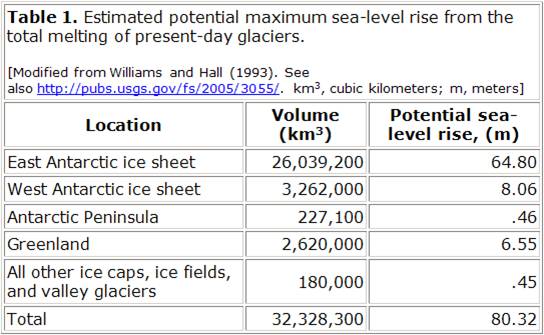 | If Earth’s climate continues to warm, then the volume of present-day ice sheets will decrease. Melting of the current Greenland ice sheet would result in a sea-level rise of about 6.5 meters; melting of the West Antarctic ice sheet would result in a sea-level rise of about 8 meters (table 1). The West Antarctic ice sheet is especially vulnerable, because much of it is grounded below sea level. Small changes in global sea level or a rise in ocean temperatures could cause a breakup of the two buttressing ice shelves (Ronne/Filchner and Ross). The resulting surge of the West Antarctic ice sheet would lead to a rapid rise in global sea level. Reduction of the West Antarctic and Greenland ice sheets similar to past reductions would cause sea level to rise 10 or more meters. A sea-level rise of 10 meters would flood about 25 percent of the U.S. population, with the major impact being mostly on the people and infrastructures in the Gulf and East Coast States (fig. 3). Researchers at the U.S. Geological Survey and elsewhere are investigating the magnitude and timing of sea-level changes during previous interglacial intervals. Better documentation and understanding of these past changes will improve our ability to estimate the potential for future large-scale changes in sea level. | | | Source: USGS | URL: http://pubs.usgs.gov/fs/fs2-00/
(The text for the image(s) on this Web page was taken from the above source.) |
| Mean cumulative mass balance of all reported glaciers (blue line) and the reference glaciers (red line). | 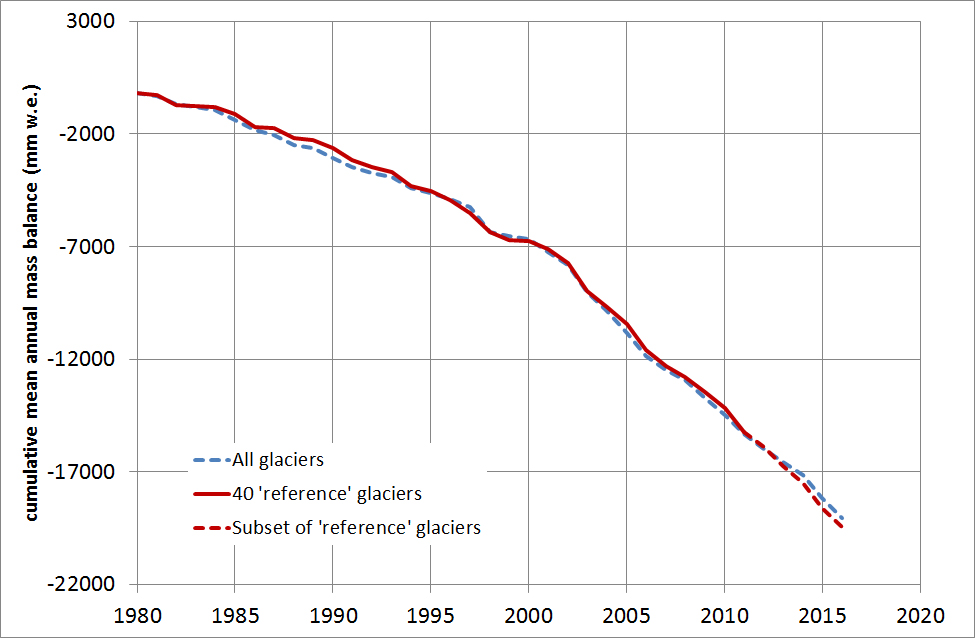
Does not include Greenland or Antarctica | Table 2: Reference glaciers with continuous long-term observation series. Mountain range Glaciers Alaska Gulkana, Wolverine Pacific Coast Ranges Place, South Cascade, Helm, Lemon Creek, Peyto, Columbia (2057) Andes Echaurren Norte Canadian High Arctic Devon Ice Cap NW, Meighen Ice Cap, White, Melville South Ice Cap Svalbard Austre Broeggerbreen, Midtre Lovénbreen Scandinavia Engabreen, Alfotbreen, Nigardsbreen, Grasubreen, Storbreen, Hellstugubreen, Remebesdalsskaaka (Hardangerjoekulen), Storglaciaeren Alps Saint Sorlin, Sarennes, Argentière, Silvretta, Gries, Stubacher Sonnblickkees, Vernagtferner, Kesselwandferner, Hintereisferner, Caresèr, Wurtenkees Caucasus Djankuat Altai No. 125 (Vodopadniy), Maliy Aktru, Leviy Aktru Tien Shan Ts. Tuyuksuyskiy, Urumqi Glacier No.1 | | | Source: world glacier monitoring service | | URL: http://wgms.ch/latest-glacier-mass-balance-data/ |
| Other ice caps and glaciers in the northern hemisphere are melting faster too | 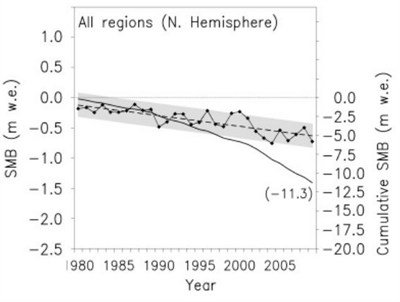
Surface mass balance of ice caps and glaciers in the northern hemisphere - excluding the Greenland Ice Sheet - showing a loss (dashed line) between 1970 and 2009. Annual values are marked by black circles. The solid black line is the cumulative ice loss over the period. Source: Mernild et al., ( 2014) | As well as the Greenland and Antarctic ice sheets, glaciers and ice caps on land are also melting under the pressure of rising temperatures and contributing to sea level rise.
A new paper published today in the Journal of Climate looks at ice-covered areas greater or equal to 0.5 square kilometres in the Northern Hemisphere, excluding the Greenland Ice Sheet.
The researchers built a model of glacier and ice cap responses to past temperature and snowfall changes, testing it against nearly 1500 measurements from 78 locations worldwide.
The scientists estimated the total contribution to sea-level rise from ice caps and glaciers was 0.51 millimetres per year between 1979-2009. But it's speeding up - looking just at the recent decade, 1999-2009, the contribution is 40 per cent higher, at around 0.71 millimetres per year. | | | Source: carbonbrief | URL: http://www.carbonbrief.org/blog/2014/05/ice-picks-five-pieces-of-ice-news-revealing-earth%E2%80%99s-ice-cover-is-in-serious-decline/
(The text for the image(s) on this Web page was taken from the above source.) |
| Sea level rise contributors | 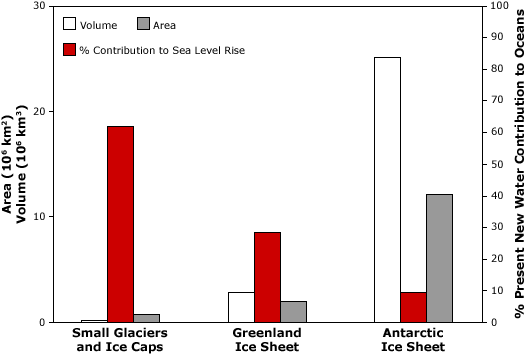
Sea level rise contributors
Comparison of volume (white), area (grey) and percent contribution to sea level rise (red) by small glaciers and ice caps, and the Greenland and Antarctic Ice Sheets. Image courtesy (Meier et al., 2007). | Current conditions: contribution from melting glaciers
Global sea level is currently rising as a result of both ocean thermal expansion and glacier melt, with each accounting for about half of the observed sea level rise, and each caused by recent increases in global mean temperature. For the period 1961-2003, the observed sea level rise due to thermal expansion was 0.42 millimeters per year and 0.69 millimeters per year due to total glacier melt (small glaciers, ice caps, ice sheets) (IPCC 2007). Between 1993 and 2003, the contribution to sea level rise increased for both sources to 1.60 millimeters per year and 1.19 millimeters per year respectively (IPCC 2007).
Antarctica and Greenland, the world's largest ice sheets, make up the vast majority of the Earth's ice. If these ice sheets melted entirely, sea level would rise by more than 70 meters. However, current estimates indicate that mass balance for the Antarctic ice sheet is in approximate equilibrium and may represent only about 10 percent of the current contribution to sea level rise coming from glaciers. However, some localized areas of the Antarctic have recently shown significant negative balance, e.g., Pine Island and Thwaites Glaciers, and glaciers on the Antarctic Peninsula. There is still much uncertainty about accumulation rates in Antarctica, especially on the East Antarctic Plateau. The Greenland Ice Sheet may be contributing about 30 percent of all glacier melt to rising sea level. Furthermore, recent observations show evidence for increased ice flow rates in some regions of the Greenland Ice Sheet, suggesting that ice dynamics may be a key factor in the response of coastal glaciers and ice sheets to climate change and their role in sea level rise.
In contrast to the polar regions, the network of lower latitude small glaciers and ice caps, although making up only about four percent of the total land ice area or about 760,000 square kilometers, may have provided as much as 60 percent of the total glacier contribution to sea level change since 1990s (Meier et al. 2007). | | | Source: NSIDC | URL: https://nsidc.org/cryosphere/sotc/sea_level.html
(The text for the image(s) on this Web page was taken from the above source.) |
| Small glacier/ice cap contribution | 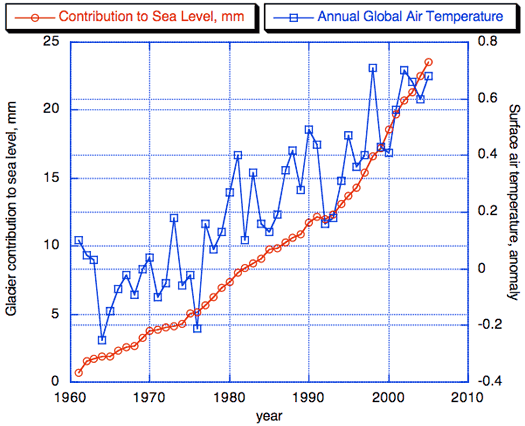
Small glacier/ice cap contribution
The cumulative contribution to sea level from small glaciers and ice caps (red) plotted with the annual global surface air temperature anomaly (blue). Image courtesy Mark Dyurgerov, Institute of Arctic and Alpine Research, University of Colorado, Boulder. | How glaciers' contribution to sea level is computed
Global mass balance data are transformed to sea-level equivalent by first multiplying the ice thickness (meters) lost to melting by the density of ice (about 900 kilograms per cubic meter), to obtain a water equivalent thickness, and then multiplying by the surface area of these "small" glaciers (about 760,000 square kilometers). This provides an annual average mass balance of approximately -0.273 meters for the period 1961 to 2005. When dividing the mass balance value by the surface area of the oceans (361.6 million square kilometers), the final result is 0.58 millimeters of sea level rise per year. The Glacier Contribution to Sea Level graph demonstrates how the contribution from melting glaciers began increasing at a faster rate starting in the 1990s. This is in agreement with high-latitude air temperature records. The IPCC (2013) stated that it was "very likely" (at least 90 percent confidence) that the mean annual global rate of ocean level increase was 1.5 to 1.9 millimeters between 1901 and 2010, 1.7 to 2.3 millimeters between 1971 and 2010, and 2.8 to 3.6 millimeters between 1993 and 2010. | | | Source: NSIDC | URL: https://nsidc.org/cryosphere/sotc/sea_level.html
(The text for the image(s) on this Web page was taken from the above source.) |
| Total Glacier Ice Decline - 1860-2010 | 
Glacier Volume is Shrinking
Cumulative decline (in cubic miles) in glacier ice worldwide. Click Global Climate Change Impacts in the U.S.">here for more information | Warming temperatures lead to the melting of glaciers and ice sheets. The total volume of glaciers on Earth is declining sharply. Glaciers have been retreating worldwide for at least the last century; the rate of retreat has increased in the past decade. Only a few glaciers are actually advancing (in locations that were well below freezing, and where increased precipitation has outpaced melting). The progressive disappearance of glaciers has implications not only for a rising global sea level, but also for water supplies in certain regions of Asia and South America. | | | Source: NOAA | URL: https://downloads.globalchange.gov/usimpacts/pdfs/climate-impacts-report.pdf
(The text for the image(s) on this Web page was taken from the above source.) |
|
|